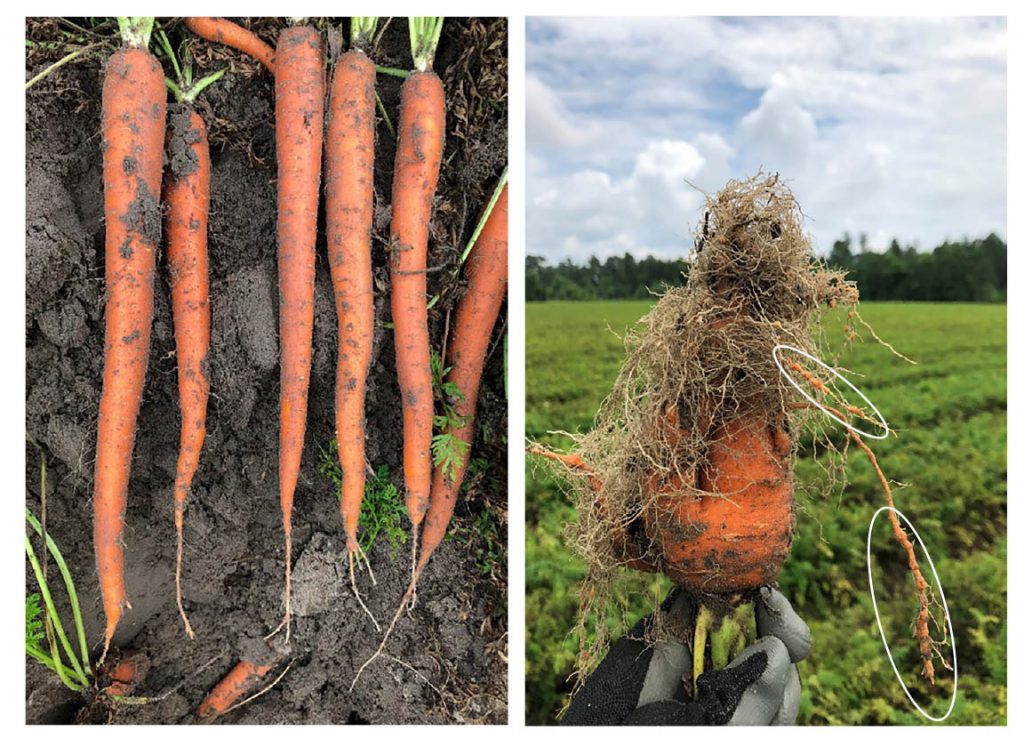
By Abolfazl Hajihassani
Plant-parasitic nematodes are known as hidden enemies and restrain carrot production in the United States. In Georgia, carrots are among the most seriously affected vegetables due to heavy infestation of root-knot nematodes. These pests cause especially severe problems in sandy-textured soils in all carrot-growing areas. Three major species — Meloidogyne incognita, M. arenaria and M. javanica — are important in South Georgia. M. incognita and M. arenaria are widespread, but M. javanica has limited dispersal.
Root-knot nematodes can be managed through various approaches, including field monitoring and sanitation, rotation to non-host or cover crops, resistant cultivars, and nematicides. Prevention is always more effective and cheaper than control treatments when it comes to root-knot nematode management. Pre-plant soil sampling for accurate nematode identity and counts is a crucial step in assessing the risk that nematodes can pose to directly-seeded carrots. Root-knot nematode population densities usually are lowest at planting and highest around crop maturity.
SUPPRESSION METHODS
One method to suppress root-knot nematode populations in soil is to rotate carrots with non-host or poor host crops. However, care should be taken when planting a cover crop because some cultivars are susceptible to root-knot nematodes, allowing an increase in nematode population density in soil rather than suppressing them.
Leaving land to fallow for a short period of time, like one year, is not effective in reducing root-knot nematode numbers in soil. The most effective and long-term control strategy for carrot production is the use of genetically resistant and/or tolerant cultivars. The source of nematode resistance has been detected in wild accessions or lines of carrots. However, there are currently no commercial carrot cultivars available with resistance to root-knot nematodes. Chemical nematicides are therefore important elements in the suppression or eradication of root-knot nematodes in carrot production.
RESEARCH RESULTS ON CHEMICAL CONTROLS
In an on-farm trial, the efficacy of pre-plant soil fumigation with 1) TeloneII (at 12 gallons per acre), 2) chloropicrin, Pic-100 (at two rates of 100 and 150 pounds per acre) and 3) their combined product, Pic-80 (at 100 and 150 pounds per acre) was evaluated in a field with high M. incognita pressure.

Fumigant applications were made four weeks before carrot seeding into the field. Broadcast applications of Telone II were made with a Harrell six-bottom switch plow with knives spaced 20 inches apart. Pic-80 and Pic-100 were applied with a tractor through subsurface knives (five knives placed 12 inches deep) during bed formation. Researchers found that all three fumigant products did not completely kill root-knot nematodes. The pests were able to develop and damage carrots during the growing season.
Carrot plants in the fumigant-treated plots had significantly lower nematode numbers, gall ratings and root ratings than the untreated control. Plots treated with Telone II often had numerically reduced nematode numbers and gall ratings compared to the plots treated with both Pic-80 and Pic-100.
Yield was not significantly different between treated and untreated plots, but yield in the plots treated with Pic-100 (100 pounds per acre) and Pic-80 (100 pounds per acre) was numerically higher than that of the Telone treatment. These results show that Telone II has higher root-knot nematode control compared to mixed formulations of Telone+chloropicrin. However, little or no difference in the crop yield was observed between the nematicide treatments examined. Telone II only helps control nematodes. On the other hand, Telone+chloropicrin mixtures have broader activities and control several soilborne diseases.
Even with pre-plant fumigation, crop damage is still likely to occur. For example, in a commercial carrot farm in South Georgia, Telone II at 12.5 gallons per acre was applied before seeding carrots. The plants showed poor growth and stunted foliage across the field due to severe root-knot nematode infestation with small galls present on the roots approximately three months after planting. In this field, two applications of Vydate L at 64 fluid ounces per acre was made during the growing season. The nematicide was broadcast applied by a tractor sprayer prior to rain events to move the nematicide into the root zone.
Results showed that the nematode population density in treated plots was numerically lower but not significantly different than the nematode count in untreated plots. Numerical reductions were found at harvest in nematode numbers and gall ratings in treated plots compared to the untreated plots. No significant difference was found in carrot yield between treated and untreated plots. The systemic activity of Vydate seems to reduce the nematode development in infected roots, resulting in relatively better control and lower yield loss.
CONCLUSION
In conclusion, nematode management in carrot is heavily dependent on nematicides. Pre-plant soil fumigation has been the crucial option used in carrot production to manage root-knot and other pathogenic nematodes. Old (e.g., Vydate) and newly introduced non-fumigant nematicides (e.g., fluopyram or fluensulfone) have also been shown to provide reliable nematode control and, thus, are recommended for use in carrot production.
Abolfazl Hajihassani is an assistant professor of nematology at the University of Georgia in Tifton.









